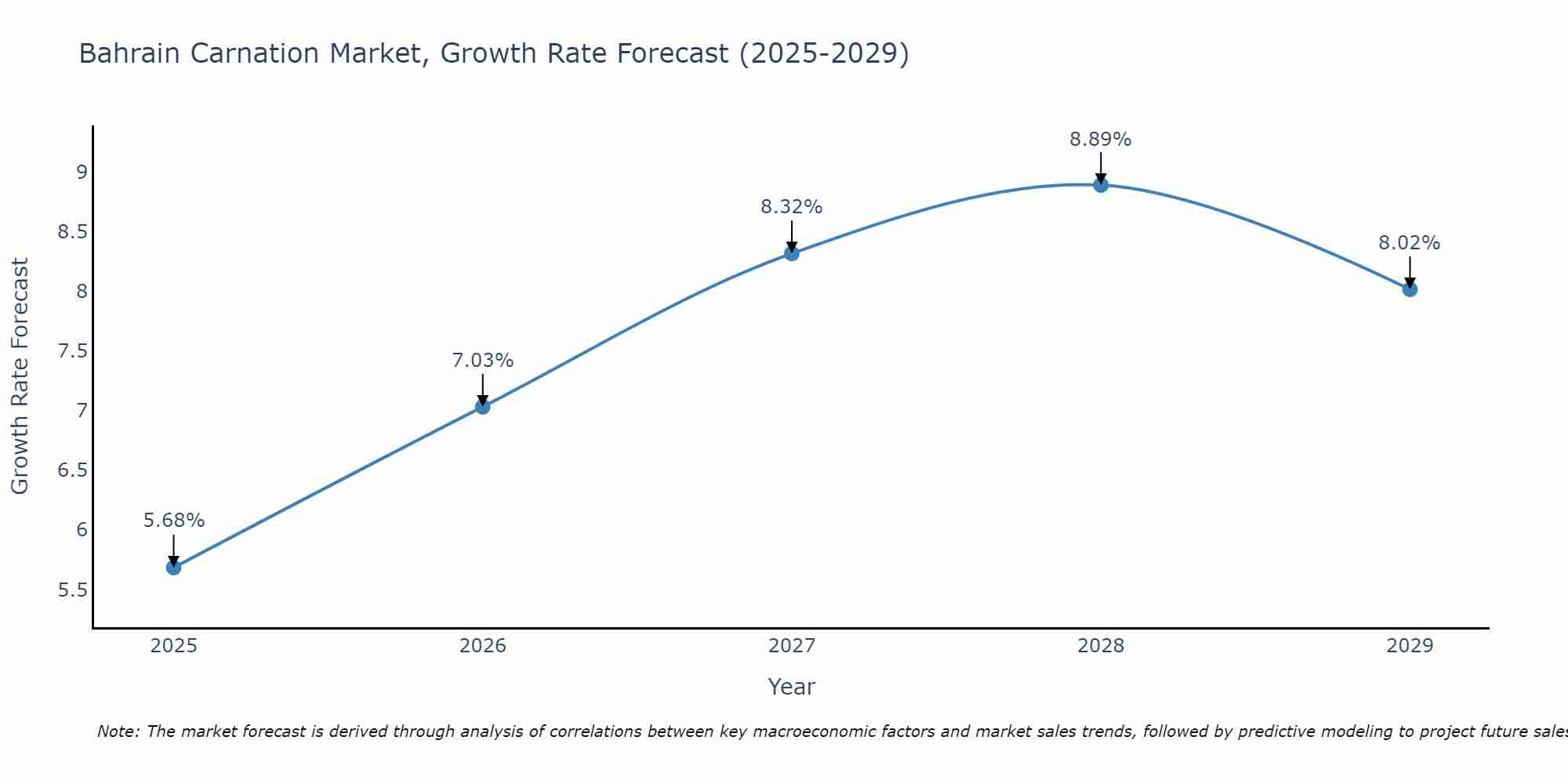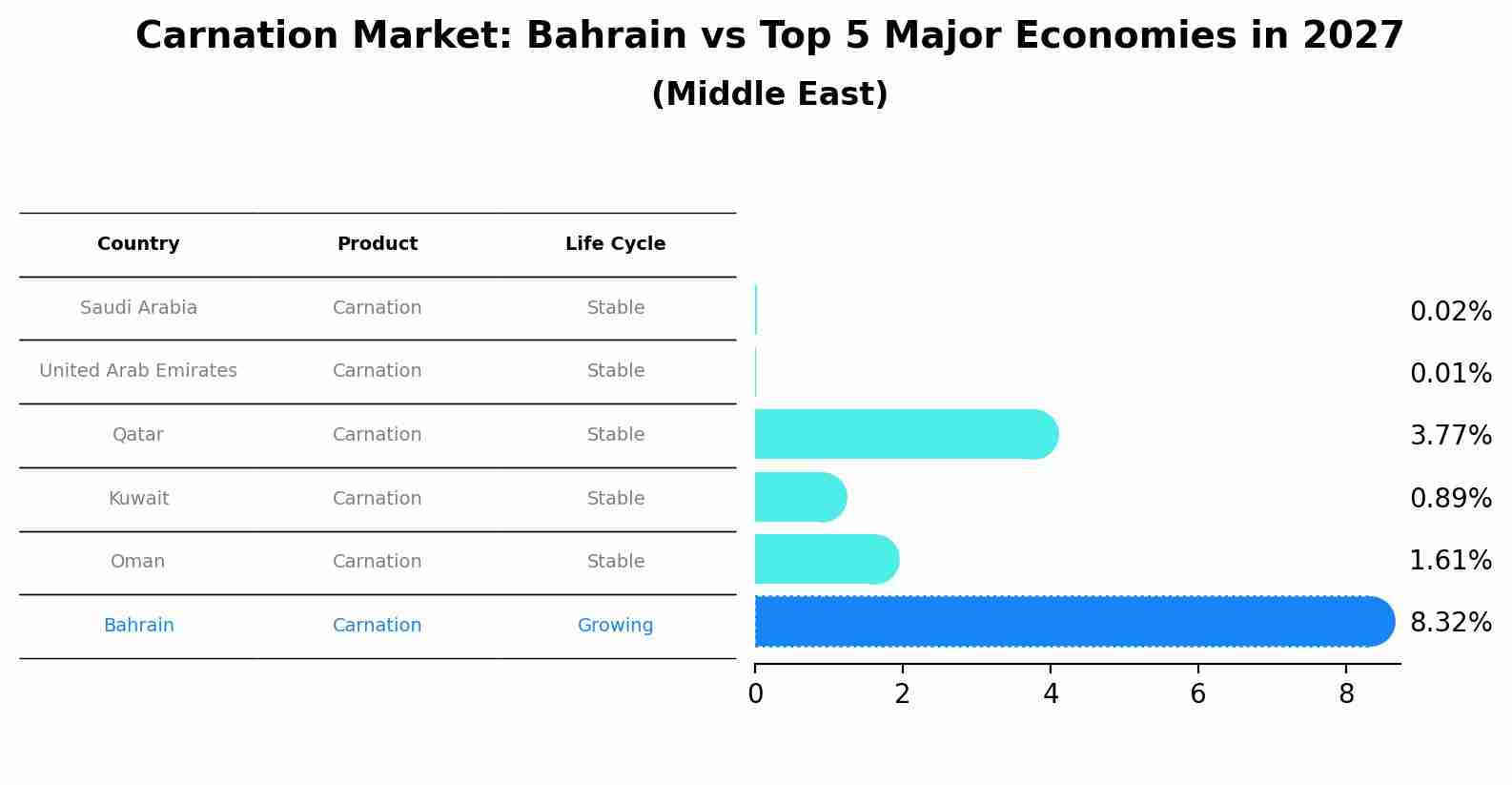Bahrain Carnation Market (2025-2031) Outlook | Growth, Trends, Revenue, Forecast, Size, Analysis, Companies, Industry, Value & Share
| Product Code: ETC409000 | Publication Date: Oct 2022 | Updated Date: Apr 2025 | Product Type: Market Research Report | |
| Publisher: 6Wresearch | Author: Shubham Padhi | No. of Pages: 75 | No. of Figures: 35 | No. of Tables: 20 |
Bahrain Carnation Market Size Growth Rate
The Bahrain Carnation Market is projected to witness mixed growth rate patterns during 2025 to 2029. Growth accelerates to 8.89% in 2028, following an initial rate of 5.68%, before easing to 8.02% at the end of the period.

Carnation Market: Bahrain vs Top 5 Major Economies in 2027 (Middle East)
The Carnation market in Bahrain is projected to grow at a growing growth rate of 8.32% by 2027, within the Middle East region led by Saudi Arabia, along with other countries like United Arab Emirates, Qatar, Kuwait and Oman, collectively shaping a dynamic and evolving market environment driven by innovation and increasing adoption of emerging technologies.

Bahrain Carnation Market
The carnation market in Bahrain caters to the floral industry, serving both domestic and export markets. Carnations are popular flowers used in various occasions such as weddings, festivals, and funerals. The market dynamics are influenced by factors such as seasonal demand, consumer preferences for floral arrangements, and trends in event planning and decoration.
Drivers of the market
The Bahrain Carnation market is experiencing significant growth driven by the increasing demand for cut flowers, floral arrangements, and ornamental plants, the rising popularity of floral gifting culture, and the growing events and hospitality industry. Carnations are perennial flowering plants prized for their fragrant blooms, vibrant colors, and long-lasting freshness. The expanding floral retail sector, the rise of online flower delivery services, and the growing trend towards weddings, parties, and corporate events in Bahrain are driving the consumption of carnations. Moreover, the benefits of affordability, versatility, and symbolism associated with carnations are further fueling market growth, enabling florists and event planners to create beautiful and memorable floral arrangements for various occasions.
Challenges of the market
Challenges in the Bahrain Carnation Market include the seasonality and perishability of fresh carnation flowers, which impact the availability and pricing of carnation products throughout the year. Additionally, concerns about post-harvest handling, transportation logistics, and market competition pose challenges for floriculture growers and distributors in meeting consumer demand and quality expectations.
Government Policy of the market
Government regulations may govern agricultural practices, phytosanitary standards, and trade tariffs for carnation cultivation and trade. Policies may include agricultural subsidies, pest control regulations, and export promotion initiatives to support Bahrain carnation growers and facilitate international trade in carnation flowers and products.
Key Highlights of the Report:
- Bahrain Carnation Market Outlook
- Market Size of Bahrain Carnation Market, 2024
- Forecast of Bahrain Carnation Market, 2031
- Historical Data and Forecast of Bahrain Carnation Revenues & Volume for the Period 2021-2031
- Bahrain Carnation Market Trend Evolution
- Bahrain Carnation Market Drivers and Challenges
- Bahrain Carnation Price Trends
- Bahrain Carnation Porter's Five Forces
- Bahrain Carnation Industry Life Cycle
- Historical Data and Forecast of Bahrain Carnation Market Revenues & Volume By Products Type for the Period 2021-2031
- Historical Data and Forecast of Bahrain Carnation Market Revenues & Volume By Standard Carnation for the Period 2021-2031
- Historical Data and Forecast of Bahrain Carnation Market Revenues & Volume By Miniature Carnation for the Period 2021-2031
- Historical Data and Forecast of Bahrain Carnation Market Revenues & Volume By Application for the Period 2021-2031
- Historical Data and Forecast of Bahrain Carnation Market Revenues & Volume By Domestic Field for the Period 2021-2031
- Historical Data and Forecast of Bahrain Carnation Market Revenues & Volume By Business Field for the Period 2021-2031
- Bahrain Carnation Import Export Trade Statistics
- Market Opportunity Assessment By Products Type
- Market Opportunity Assessment By Application
- Bahrain Carnation Top Companies Market Share
- Bahrain Carnation Competitive Benchmarking By Technical and Operational Parameters
- Bahrain Carnation Company Profiles
- Bahrain Carnation Key Strategic Recommendations
Frequently Asked Questions About the Market Study (FAQs):
- Single User License$ 1,995
- Department License$ 2,400
- Site License$ 3,120
- Global License$ 3,795
Search
Thought Leadership and Analyst Meet
Our Clients
Related Reports
- Germany Breakfast Food Market (2026-2032) | Industry, Share, Growth, Size, Companies, Value, Analysis, Revenue, Trends, Forecast & Outlook
- Australia Briquette Market (2025-2031) | Growth, Size, Revenue, Forecast, Analysis, Trends, Value, Share, Industry & Companies
- Vietnam System Integrator Market (2025-2031) | Size, Companies, Analysis, Industry, Value, Forecast, Growth, Trends, Revenue & Share
- ASEAN and Thailand Brain Health Supplements Market (2025-2031) | Strategy, Consumer Insights, Analysis, Investment Trends, Opportunities, Growth, Size, Share, Industry, Revenue, Segments, Value, Segmentation, Supply, Forecast, Restraints, Outlook, Competition, Drivers, Trends, Demand, Pricing Analysis, Competitive, Strategic Insights, Companies, Challenges
- ASEAN Bearings Market (2025-2031) | Strategy, Consumer Insights, Analysis, Investment Trends, Opportunities, Growth, Size, Share, Industry, Revenue, Segments, Value, Segmentation, Supply, Forecast, Restraints, Outlook, Competition, Drivers, Trends, Demand, Pricing Analysis, Competitive, Strategic Insights, Companies, Challenges
- Europe Flooring Market (2025-2031) | Outlook, Share, Industry, Trends, Forecast, Companies, Revenue, Size, Analysis, Growth & Value
- Saudi Arabia Manlift Market (2025-2031) | Outlook, Size, Growth, Trends, Companies, Industry, Revenue, Value, Share, Forecast & Analysis
- Uganda Excavator, Crane, and Wheel Loaders Market (2025-2031) | Strategy, Consumer Insights, Analysis, Investment Trends, Opportunities, Growth, Size, Share, Industry, Revenue, Segments, Value, Segmentation, Supply, Forecast, Restraints, Outlook, Competition, Drivers, Trends, Demand, Pricing Analysis, Competitive, Strategic Insights, Companies, Challenges
- Rwanda Excavator, Crane, and Wheel Loaders Market (2025-2031) | Strategy, Consumer Insights, Analysis, Investment Trends, Opportunities, Growth, Size, Share, Industry, Revenue, Segments, Value, Segmentation, Supply, Forecast, Restraints, Outlook, Competition, Drivers, Trends, Demand, Pricing Analysis, Competitive, Strategic Insights, Companies, Challenges
- Kenya Excavator, Crane, and Wheel Loaders Market (2025-2031) | Strategy, Consumer Insights, Analysis, Investment Trends, Opportunities, Growth, Size, Share, Industry, Revenue, Segments, Value, Segmentation, Supply, Forecast, Restraints, Outlook, Competition, Drivers, Trends, Demand, Pricing Analysis, Competitive, Strategic Insights, Companies, Challenges
Industry Events and Analyst Meet
Whitepaper
- Middle East & Africa Commercial Security Market Click here to view more.
- Middle East & Africa Fire Safety Systems & Equipment Market Click here to view more.
- GCC Drone Market Click here to view more.
- Middle East Lighting Fixture Market Click here to view more.
- GCC Physical & Perimeter Security Market Click here to view more.
6WResearch In News
- Doha a strategic location for EV manufacturing hub: IPA Qatar
- Demand for luxury TVs surging in the GCC, says Samsung
- Empowering Growth: The Thriving Journey of Bangladesh’s Cable Industry
- Demand for luxury TVs surging in the GCC, says Samsung
- Video call with a traditional healer? Once unthinkable, it’s now common in South Africa
- Intelligent Buildings To Smooth GCC’s Path To Net Zero


















